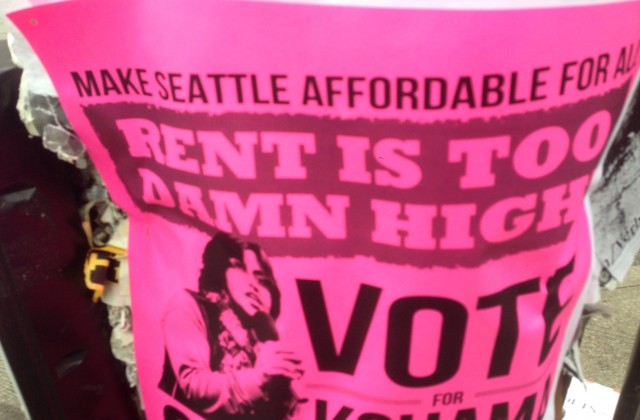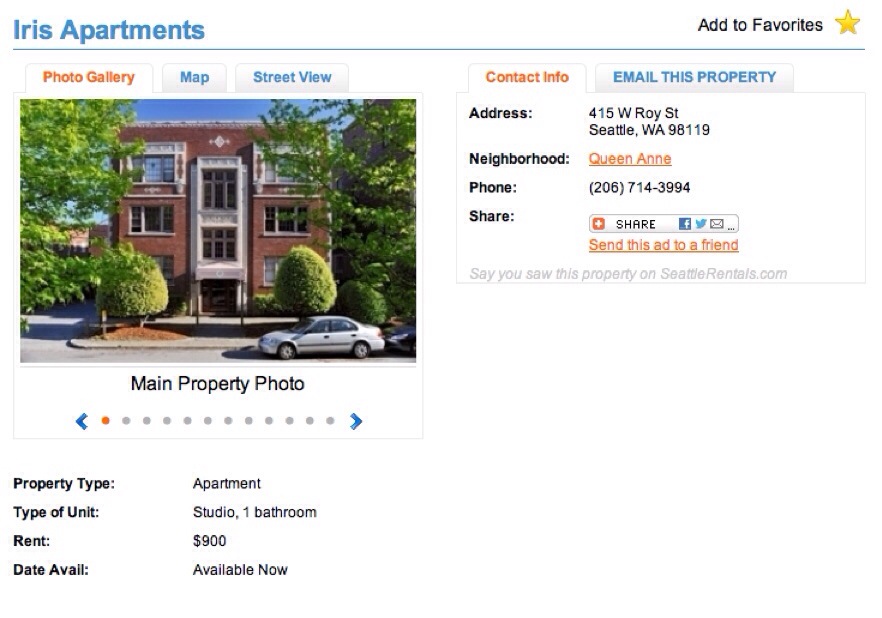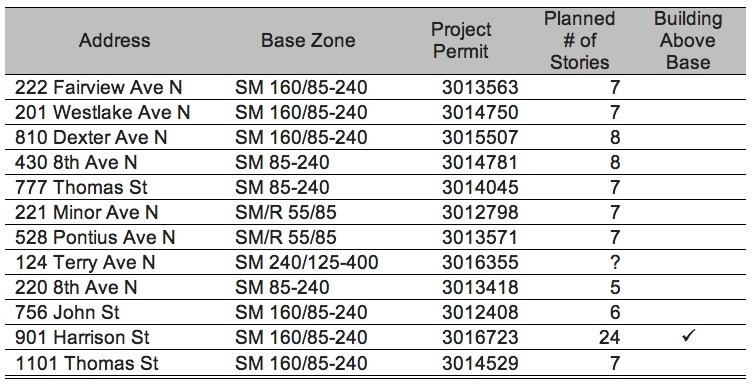Think housing is expensive? Just wait until it’s affordable.
There is a question haunting Seattle—the question of affordability. Throughout the city many people feel like things in Seattle—especially housing—are too expensive. But what is affordable and what isn’t? And if housing prices are too high for people with certain levels of income, what’s the best way to fix that? And what is the City of Seattle considering now and will it help or make things worse? Is there a better solution?
What is affordable?
Affordability is the quantitative or qualitative measure of a relationship to price. According the government, a person shouldn’t spend more than 30 percent of their gross monthly income on housing. A discount for income is applied to this percentage when considering which people to subsidize. Anybody earning 60 percent or less of Area Median Income (AMI) is considered to have a low enough income to need help with rent. By this measure, a couple in Seattle earning $51,150 (80 percent of AMI), for example, can afford housing costs of $1,198 per month.
The biggest driver of housing policy in Seattle these days is not the more than 3,000 people who sleep outside each night or housing for lower income families but something called “workforce housing.” The City defines workforce housing as housing that is priced affordably (according to the measure described above) for people earning 60 to 80 percent of AMI, or $1,075 to $1,198 for a one-bedroom apartment.
Is workforce housing hard to find?
According to the Consolidated Housing and Community Development Plan released by King County the answer is a clear, “No.” Here’s what that plan says about workforce housing in Seattle:
For those moderate income renters, the supply is much more than adequate in all of the sub-regions . . . 38 to 42 percent of all rental units throughout the County are affordable at the moderate income level (75).
And the plan also finds that,
While there appears to be an adequate supply of rental housing for those at 60 percent AMI and above, there is a very inadequate supply of rental housing for households earning 40 percent of median household income or less (69).
There really isn’t lack of supply of housing for people earning 60 to 80 percent of AMI; the real problem is at lower levels of income.
But here’s what the City Council says about workforce housing:
Many retail and service workers that support Seattle’s economic prosperity have difficulty living in the city where they work. Even nurses, teachers, construction workers and many other middle-wage workers face barriers to living in Seattle. For example, a public school teacher’s starting salary of $42,000 suggests that he or she should not pay more than $1,050 per month (30%) for housing. Yet the average rent in Seattle for a 2 bedroom / 1 bath apartment is $1,466.
The logic of the City Council goes like this. Retail workers have a tough time living here. Teachers have are hard time finding a place to live. The teacher who starts out in his first job at $42,000 per year can’t afford a two-bedroom apartment at $1,466.
Wait. Are we talking about retail workers or teachers? And why does this new teacher need a two-bedroom apartment? Is the Council talking about a teacher with a partner who earns no money, since the figure they cite seems based on the City’s normative standard for a couple earning that much? Recent reports peg the average base pay for teachers at about $49,000 per year.
The strained logic of the Council and their example seem to be motivated by the need to create sympathetic case: a poor teacher who would have to spend roughly 42 percent of gross income on housing for a two-bedroom apartment. But their example seems premised on a couple not a single teacher.
What about a one-bedroom unit for our single teacher? A search of Seattlerents.com for apartments between $900 and $1,000 turns up this unit below at the very top of the results.
At $900 per month, our teacher would be paying roughly 26 percent of his income on housing. That’s good isn’t it? And it also is anecdotal validation of the King County Data: there is not a lack of supply of housing choices for people earning 60 to 80 percent of Area Median Income. So there does not appear to be a problem with a lack of supply of workforce housing in Seattle.
Is Incentive Zoning a solution looking for a problem, or is it creating one?
The City is currently charging developers in some areas a fee to build housing over and above existing zoning; instead of a “buy one, get one for half price,” the program is a “buy one get the second one for 11 percent more than what you paid for the first one.” The idea behind the fee—called Incentive Zoning—is that developers will collect more rent from additional units, and therefore more profit if they are allowed to build more density than underlying zoning. Why not capture some of that profit to pay for workforce housing?
Notwithstanding the fact that there does not appear to be a lack of options for people earning 60 to 80 percent of AMI is this fee a good idea? Does this policy of charging developers money to build more housing work? Even though we don’t need more workforce housing but more housing for poorer people, does the fee spur more housing development? Is it really an incentive?
Based on one analysis by the Downtown Seattle Association many new projects simply aren’t taking the “incentive” and choosing not to build additional housing.
Of the 14 projects in this review only two are taking the bonus and the fee that goes with it. Why would developers walk away from all this extra density and extra profits?
In a recent article in the Daily Journal of Commerce Tom Parsons of Holland Development spoke to the issue of why builders don’t see the incentive as, well, an incentive:
Once a structure goes above seven stories, construction materials shift from mostly wood to concrete and other materials that can cost 30 percent more, Parsons said. Developers also must pay for low income housing to reach 125 feet under the South Lake Union rezone, so Parsons said shorter buildings are a better financial choice for these blocks.
“You put all those things together and look at what the market is willing to pay in rent, and the density we can build at base (zoning) is adequate, and it provides the best financial return to our investors,” Parsons said.
The “low income housing” Parsons is referring to is workforce housing, something already being adequately provided by the market. And Parsons doesn’t lay all the blame on the fee, but the fee is part of what tips the scale resulting in less public benefit from more housing and funds for housing.
Based on the numbers it looks like the program which is intended to “incentivize” more building is actually discouraging it. There are risks and costs associated with building more units and the fee simply adds another one. Instead of stoking supply of new market rate housing, and gathering fees from the building of that new housing to help solve housing need, the fee is discouraging market rate supply and not really building very much new subsidized housing either. The fee is making things worse. If we don’t have a problem in workforce housing now we sure will if the City continues to tax new growth and development.
Even if there were a serious lack of housing priced at workforce levels—60 to 80 percent of AMI, the incentive tool probably wouldn’t solve it. Meanwhile lower income people and families struggle to find a place to live and thousands of others sleep outside in the cold every night.
The incentive program part of the housing problem in Seattle reducing housing supply overall by actually discouraging more building. Maybe developers are lying when they say it’s not worth it to take the bonus units they get by paying the fee. But with the risks that are already inherent with building additional height why add more? And whether you believe them or not, evidence shows builders aren’t paying the fee, which means less money to subsidize anything, even the actual problem.
What’s the answer?
The answer is more housing supply. When the market creates a surplus that means lower prices. Add fees, costs and supply will go down and prices will rise. What the fee on new development does is tax a thing we want more of in our city, jobs and people. If we want to encourage more housing we’d reduce the costs and risks associated with building more instead of adding both with fees.
Letting market rate developers build what they can finance will result in more competition between landlords for tenants. More housing means better deals for everyone looking for a place to live. If banks and investors can’t be paid back for lower priced units, housing, or shelter that’s where subsidies or even less regulation are indicated. Making the case for this is going to take more than just one (long) blog post, but we need to challenge the assumptions being issued from City Hall about housing prices and how we can lower them for all levels of income.




